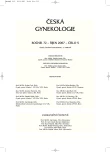-
Medical journals
- Career
Prediction of Preeclampsia Using the Integrated Test Markers
Authors: P. Urdzík; R. Dankovčík; A. Ostró; I. Lazár
Authors‘ workplace: II. gynekologicko–pôrodnícka klinika LF UPJŠ a FN L. Pasteura, Košice, prednosta prof. MUDr. A. Ostró, CSc.
Published in: Ceska Gynekol 2007; 72(5): 336-343
Category: Original Article
Overview
Objective:
Author’s objective was to ascertain the option for prediction of preeclampsia using the integrated test markers on the population of pregnant women in Košice city.Design:
Retrospective, longitudinal, multicenter study.Setting:
2nd Department of Obstetrics and Gynecology University of P. J. Šafárik, Košice, Slovak Republic.Methods:
The study group comprised 578 pregnant patients of 2nd Department of Obstetrics and Gynecology, the period from 01.11.2001 until 31.01.2005 for integrated test consisting of (CRL, NT, concentration of PAPP-A, uE3, hCG, AFP). Primary outcome was defined as incidence of preeclampsia during pregnancy. Data on incidence of preeclampsia was collected from birth journals and records in 578 patients retrospectivelly. In order to make use of the summary information provided by the markers we have used the method of logistic regression to identify statistically significant predictors of the binary outcome measure of preeclampsia. First we developed an equation based on all available predictors. Statistically insignificant predictors were gradually eliminated from the model (Stepwise regression) until the final model remained, for which a ROC curve was developed and values of sensitivity, specificity, positive and negative predictive values at 5% FP (false positivity) were calculated.Results:
The final model of preeclampsia, which is based only on statistically significant markers of integrated test achieved – at 5% FP and 95% specificity – 36,4% sensitivity and 22,7% positive and 97,4 negative predictive value for prediction of preeclampsia in pregnant women.Conclusion:
Our results, as well as the results of other studies, lead to the conclusion, that in spite of the multitude of biochemical markers and various options for their combination with ultrasound markers for prediction of preeclampsia, so far it has been impossible to find a combination which would meet the following criteria: 1. high sensitivity and specificity at low false positive values and high positive and negative predictive value, 2. application as a screening method for prediction of preeclampsia in unselected population of pregnant women.Key words:
preeclampsia, prediction, integrated test
Labels
Paediatric gynaecology Gynaecology and obstetrics Reproduction medicine
Article was published inCzech Gynaecology

2007 Issue 5-
All articles in this issue
- Inherited Metabolic Disorders and Pregnancy
- Sperm Banking before Gonadotoxic Treatment – 11-years Experience
- Lycopene Therapy in Male Infertility
- Socioeconomic Datas, the Course of Pregnancy and Delivery in Opioid-addicted Women and Women under Substitution Therapy
- Prediction of Preeclampsia Using the Integrated Test Markers
- Determination Concentrations of Tissue Factor Pathway Inhibitor and their Changes during Estrogen Replacement Therapy
- Progression and Regression Low Grade Intraepitelial Squamous Lesions in Context of Positivity of High Risk Human Papillomavirus
- Basal-like Carcinoma of the Breast – the Actual Review and Clinico-Pathological Corelations
- Da Vinci Robotic Surgery in Gynaecological Oncology: a Critical Interim Appraisal
- Current Condition of Diagnosis and Therapy of Overactive Urinary Bladder in Czech Republic
- Czech Gynaecology
- Journal archive
- Current issue
- Online only
- About the journal
Most read in this issue- Inherited Metabolic Disorders and Pregnancy
- Basal-like Carcinoma of the Breast – the Actual Review and Clinico-Pathological Corelations
- Da Vinci Robotic Surgery in Gynaecological Oncology: a Critical Interim Appraisal
- Progression and Regression Low Grade Intraepitelial Squamous Lesions in Context of Positivity of High Risk Human Papillomavirus
Login#ADS_BOTTOM_SCRIPTS#Forgotten passwordEnter the email address that you registered with. We will send you instructions on how to set a new password.
- Career

